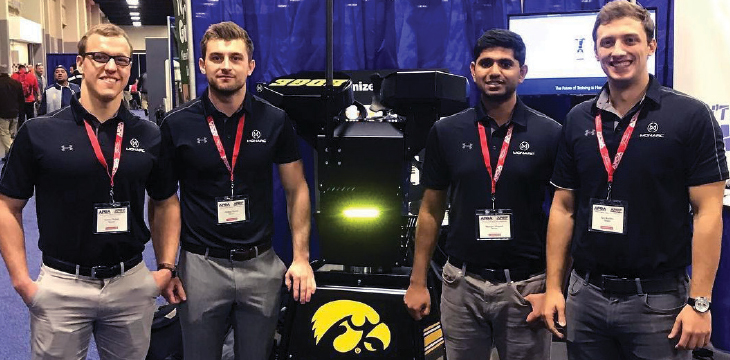RoboHawk
 PHOTO COURTESY MONARC
From left, Monarc company leaders Sawyer Theisen, Nate Pierotti, Bhaegav Magnti, and Igor Karlicic. Not pictured: Connor Early.
PHOTO COURTESY MONARC
From left, Monarc company leaders Sawyer Theisen, Nate Pierotti, Bhaegav Magnti, and Igor Karlicic. Not pictured: Connor Early.
With perfect spirals and uncanny accuracy, a hard-throwing quarterback turned heads in Iowa City this past fall. But it wasn't Hawkeye captain Nate Stanley or one of his understudies delivering footballs.
The Seeker, a high-tech training tool developed in part by UI alumni, has been seen slinging passes, punts, and kicks at the Iowa football practice facility in recent months. Billed as the world's first robotic quarterback, the Seeker may soon become a fixture on practice fields around the country.
"A lot of people need to see it to believe it, which is understandable," says Nathan Pierotti, a former UI electrical and computer engineering student. "When we first sat down with people at Iowa, they said this would be amazing if it were possible, but they couldn't imagine it working. Eighteen months later when we showed them, they were like, 'Wow, it is possible.'"
Pierotti is co-founder and CEO of Monarc, the five-person startup that created the Seeker. The company also includes software engineer Connor Early (16BSE) and sales director Sawyer Theisen (16BBA). This fall, Monarc traveled the country demonstrating its technology for university and NFL teams, and was featured in a segment on the Big Ten Network. Pierotti says the company, which recently completed its first round of capital fundraising, is in contact with 15 to 20 football teams that are interested in using the Seeker. After receiving early support from the Founders Club business incubator at the UI's John Pappajohn Entrepreneurial Center, the Monarc team has been testing prototypes at the Hawkeyes' indoor football practice facility. They aim to have their first commercial model in production by the end of the year.
The robot uses an array of sensors, motors, and software to deliver pinpoint passes to receivers wearing a tracking device on their hip. With a touchscreen interface, the machine can be programmed to hit a player in stride on a 5-yard slant, a 50-yard fade, and every route in between. Using a carousel mechanism that holds six footballs, the Seeker's motors can send the pigskin flying up to 100 yards and as fast as 65 mph while targeting specific parts of a receiver's body.
Although throwing machines have been around for decades, they've traditionally required an operator to feed, calibrate, and position the machine. The Seeker does that all autonomously while also recording player data like running speed and repetitions. The hope is to give athletes a new way to practice when a partner or coach isn't available. Says Pierotti: "We want to provide players with a better training experience."
